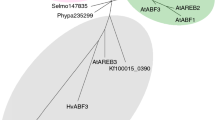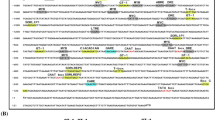Abstract
During seed maturation, the transcriptional activity of napin genes is regulated by developmental signals involving the transcriptional activator ABI3 and abscisic acid (ABA). To localize cis elements involved in the seed-specific activity of the napin napA promoter, a systematic analysis was performed focusing on two major element complexes, the B-box and RY/G. Substitution mutation analysis using promoter-reporter gene fusions in stable transgenic tobacco showed synergistic interactions between elements within these complexes. The distal part of the B-box shows similarities to abscisic acid response elements and the proximal portion contains a CA-rich element. In vitro studies involving Exonuclease III protection and electrophoretic mobility shift assays revealed binding by nuclear proteins to elements within the B-box. The distal and proximal parts of the B-box were found to bind distinct nuclear protein complexes. By gain-of-function analysis with a tetramer of the B-box fused to a truncated (−46) cauliflower mosaic virus (CaMV) 35S minimal promoter, it was demonstrated that the B-box mediates strong activity in seeds. Further, it was shown that the elements in the B-box constitute an ABA-responsive complex, since the B-box tetramer mediates ABA-responsiveness in vegetative tissues to a construct containing the CaMV virus 35S enhancer (−343 to −90). Thus, the seed-specific activity of the napA promoter relies on the combinatorial interaction between the RY/G complex and the B-box ABA-responsive complex during the ABA response in seed development.
Similar content being viewed by others
References
Ausubel, F.N., Brent, R., Kingston, R.E., Moore, D.D., Seidman, J.G., Smith, J.A. and Struhl, K. 1996. Current Protocols in Molecular Biology. John Wiley, New York.
Bate, N., Spurr, C., Foster, G.D. and Twell, D. 1996. Maturationspecific translational enhancement mediated by the 5?-UTR of a late pollen transcript. Plant J. 10: 613–623.
Bäumlein, H., Nagy, I., Villarroel, R., Inzé, D. and Wobus, U. 1992. Cis-analysis of a seed protein gene promoter: the conservative RY repeat CATGCATG within the legumin box is essential for tissue-specific expression of a legumin gene. Plant J. 2: 233–239.
Benfey, P.N. and Chua, N.H. 1990. The cauliflower mosaic virus 35S promoter: combinatorial regulation of transcription in plants. Science 250: 959–966.
Bobb, A.J., Chern, M.S. and Bustos, M.M. 1997. Conserved RY repeats mediate transactivation of seed-specific promoters by the developmental regulator PvAlf. Nucl. Acids Res. 25: 641–647.
de Bruxelles, G.L., Peacock, W.J., Dennis, E.S. and Dolferus, R. 1996. Abscisic acid induces the alcohol dehydrogenase gene in Arabidopsis. Plant Physiol. 111: 381–391.
DeLisle, A.J. and Crouch, M.L. 1989. Seed storage protein transcription and mRNA levels in Brassica napus during develop ment and in response to exogenous abscisic acid. Plant Physiol. 91: 617–623.
de Pater, S., Pham, K., Chua, N.H., Memelink, J. and Kijne, J. 1993. A 22-bp fragment of the pea lectin promoter containing essential TGAC-like motifs confers seed-specific gene expression. Plant Cell 5: 877–886.
Dixon, W.J. and Massey Jr., F.J. 1969. Introduction to Statistical Analysis, 3rd ed. McGraw-Hill, New York.
Ellerström, E., Stålberg, K., Ezcurra, I. and Rask, L. 1996. Functional dissection of a napin gene promoter: identification of promoter elements required for embryo and endosperm specific expression. Plant Mol. Biol. 32: 1019–1027.
Goldberg, R.B. 1986. Regulation of plant gene expression. Phil. Trans. R. Soc. Lond. B314: 343–353.
Guiltinan, M.J., Marcotte Jr.,W.R. and Quatrano, R.S. 1990. A plant leucine zipper protein that recognizes an abscisic acid response element. Science 250: 267–270.
Gustavsson, H.O., Ellerström, M., Stålberg, K., Ezcurra, I., Koman, A., Höglund, A.S., Rask, L. and Josefsson, L.G. 1991. Distinct sequence elements in a napin promoter interact in vivo with DNA-binding proteins from Brassica napus. Physiol. Plant. 82: 205–212.
Hattori, T., Vasil, V., Rosenkrans, L., Hannah, L.C., McCarty, D.R. and Vasil, I.K. 1992. The viviparous-1 gene and abscisic acid activate the C1 regulatory gene for anthocyanin biosynthesis during seed maturation in maize. Genes Dev. 6: 609–618.
Hattori, T., Terada, T. and Hamasuna, S. 1995. Regulation of the Osem gene by abscisic acid and the transcriptional activator VP1: analysis of cis-acting promoter elements required from regulation by abscisic acid and VP1. Plant J. 7: 913–925.
Henninghausen, L. and Lubon, H. 1985. Interaction of protein with DNA in vitro. Meth. Enzymol. 152: 721–735.
Jiang, L.W., Abrams, S.R. and Kermode, A.R. 1996. Vicilin and napin storage protein gene promoters are responsive to abscisic acid in developing transgenic tobacco seed but lose sensitivity following premature desiccation. Plant Physiol. 110: 1135–1144.
Lam, E. and Chua, N.H. 1991. Tetramer of a 21-base pair synthetic element confers seed expression and transcriptional enhancement in response to water stress and abscisic acid. J. Biol. Chem. 266: 17131–17135.
Lelievre, J.M., Oliveira, L.O. and Nielsen, N.C. 1992. 5? CATGCAT 30 elements modulate the expression of glycinin genes. Plant Physiol. 98: 387–391.
Marion-Poll, A. 1997. ABA and seed development. Trends Plant Sci. 2: 447–448.
Miner, J.N. and Jamamoto, K.R. 1992. The basic region of AP1 specifies glucocorticoid receptor activity at a composite response element. Genes Dev. 12: 2491–2501.
Nunberg, A.N., Zhuwen, L., Bogue, M.A., Vivekanda, J., Reddy, A.S. and Thomas, T.L. 1994. Developmental and hormonal regulation of sunflower helianthinin genes: proximal promoter sequences confer regionalized seed expression. Plant Cell 6: 473–486.
Ono, A., Izawa, T., Chua, N.H. and Shimamoto, K. 1996. The rab16B promoter of rice contains two distinct abscisic acidresponsive elements. Plant Physiol. 112: 483–491.
Örtoft, E., Påhlman, S., Andersson, G., Parrow, V., Betsholtz, C. and Hammerling, U. 1993. Human GAP-43 gene expression: multiple sites for initiation of transcription in differentiating human neuroblastoma cells. Mol. Cell. Neurosci. 4: 549–561.
Parcy, F., Valon, C., Raynal, M., Gaubier Comella, P., Delseny, M. and Giraudat, J. 1994. Regulation of gene expression programs during Arabidopsis seed development: roles of the AB13 locus and of endogenous abscisic acid. Plant Cell 6: 1567–1582.
Phillips, J., Artsaenko, O., Fiedler, U., Horstmann, C., Mock, H.P., Muntz, K. and Conrad, U. 1997. Seed-specific immunomodulation of abscisic acid activity induces a developmental switch. EMBO J. 16: 4489–4496.
Pla, M., Vilardell, J., Guiltinan, M.J., Marcotte, W.R., Niogret, M.F., Quatrano, R.S. and Pagès, M. 1993. The cis-regulatory element CCACGTGG is involved in ABA and water-stress responses of the maize gene rab28. Plant Mol. Biol. 21: 259–266.
Rödin, J., Sjödahl, S., Josefsson, L.G. and Rask, L. 1992. Characterization of a Brassica napus gene encoding a cruciferin subunit: estimation of sizes of cruciferin gene families. Plant Mol. Biol. 20: 559–563.
Roger, J.C. and Roger, S.W. 1992. Definition and functional implications of gibberellin and abscisic acid cis-acting hormone response complexes. Plant Cell 4: 1443–1451.
Roncarati, R., Salamini, F. and Bartels, D. 1995. An aldose reductase homologous gene from barley: regulation and function. Plant J. 7: 809–822.
Sablowski, R.W.M., Moyano, E., Culianez-Macia, F.A., Schuch, W., Martin, C. and Bevan, M. 1994. A flower-specific Myb protein activates transcription of phenylpropanoid biosynthetic genes. EMBO J. 13: 128–137.
Sambrook, J., Fritsch, E.F. and Maniatis, T. 1989. Molecular Cloning: A Laboratory Manual, 2nd ed. Cold Spring Harbor Laboratory Press, Cold Spring Harbor, NY.
Shen, Q. and Ho, T.H.D. 1995. Functional dissection of an abscisic acid (ABA)-inducible gene reveals two independent ABAresponsive complexes each containing a G-box and a novel cis-acting element. Plant Cell 7: 295–307.
Shen, Q., Zhang, P. and Ho, T.H.D. 1996. Modular nature of abscisic acid (ABA) response complexes: composite promoter units that are necessary and sufficient for ABA induction of gene expression in barley. Plant Cell 8: 1107–1119.
Skriver, K., Olsen, F.L., Rogers, J.C. and Mundy, J. 1991. cisacting DNA elements responsive to gibberellin and its antagonist abscisic acid. Proc. Natl. Acad. Sci. USA 88: 7266–7270.
Stålberg, K., Ellerström, M., Josefsson, L.G. and Rask, L. 1993. Deletion analysis of a 2S seed storage protein promoter of Brassica napus in transgenic tobacco. Plant Mol. Biol. 23: 671–683.
Stålberg, K., Ellerström, M., Ezcurra, I., Ablov, S. and Rask, L. 1996. Disruption of an overlapping E box/ABRE motif abolished high transcription of the napA storage protein promoter in transgenic Brassica napus seeds. Planta 199: 515–519.
Vasil, V. Marcotte Jr., W.R., Rosenkrans, L., Cocciolone, S.M., Vasil, I.K., Quatrano, R.S. and McCarty, D.R. 1995. Overlap of viviparous 1 (VP1) and abscisic acid response elements in the Em promoter: G-box elements are sufficient but not necessary for VP1 transactivation. Plant Cell 7: 1511–1518.
Wang, H. and Cutler, A.J. 1995. Promoters from kin1 and cor6.6, two Arabidopsis thaliana low-temperature-and ABA-inducible genes, direct strong ?-glucuronidase expression in guard cells, pollen and young developing seeds. Plant Mol. Biol. 28: 619–634.
Yamaguchi-Shinozaki, K., Mundy, J. and Chua, N.H. 1989. Four tightly linked rab genes are differently expressed in rice. Plant Mol. Biol. 14: 29–39.
Author information
Authors and Affiliations
Rights and permissions
About this article
Cite this article
Ezcurra, I., Ellerström, M., Wycliffe, P. et al. Interaction between composite elements in the napA promoter: both the B-box ABA-responsive complex and the RY/G complex are necessary for seed-specific expression. Plant Mol Biol 40, 699–709 (1999). https://doi.org/10.1023/A:1006206124512
Issue Date:
DOI: https://doi.org/10.1023/A:1006206124512




